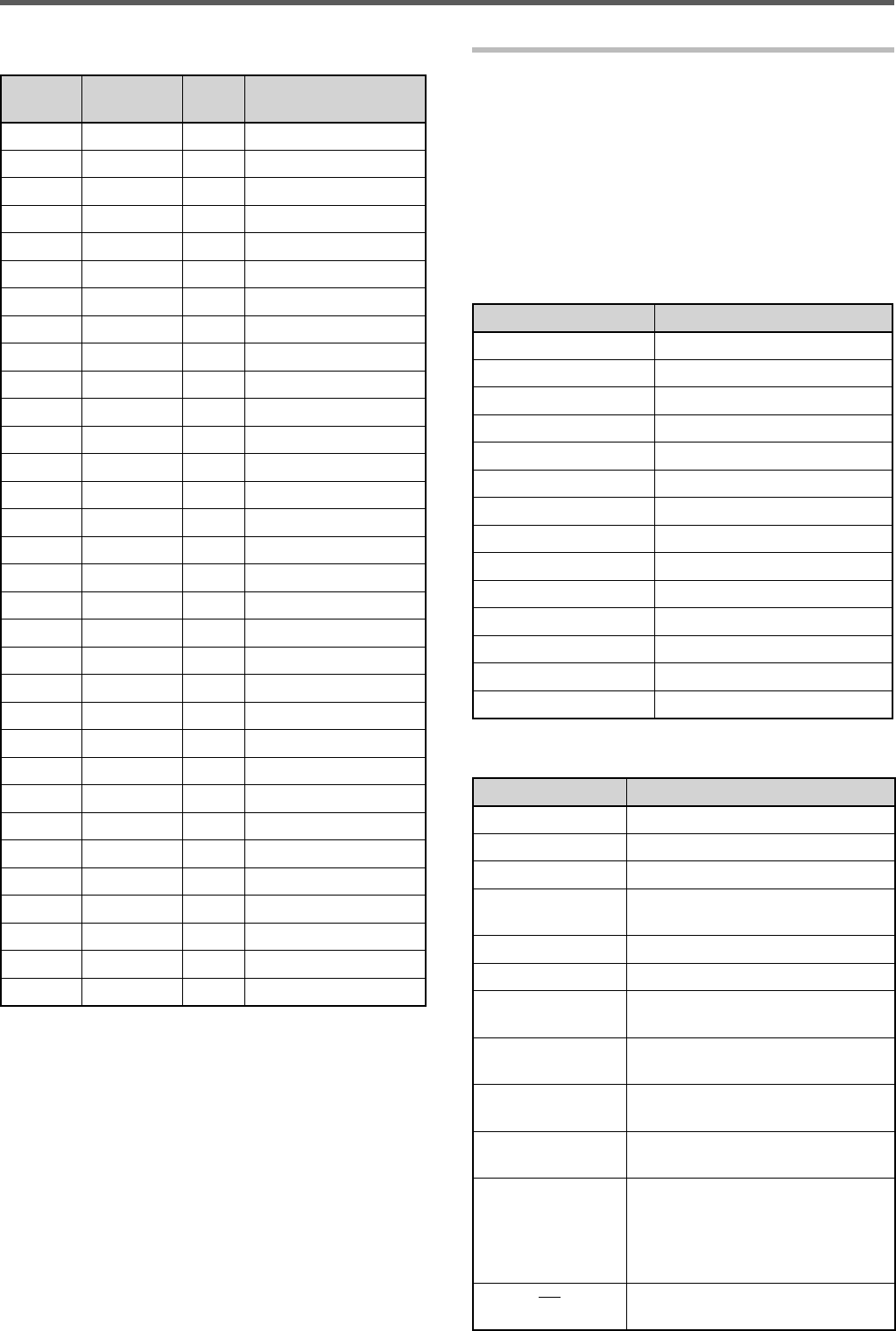
54
12 OPERATOR CONVENIENCES
BEEP FUNCTION
The Beep function provides you confi rmation of entry,
error status, and malfunctions of the transceiver.
Although you can turn the beep function OFF by
accessing Menu No. 05, we recommend you leave
it ON in order to detect unexpected errors and
malfunctions. You can also change the output level of
the beeps by accessing Menu No. 05 and selecting “1”
to “20”.
The transceiver generates the following Morse code
to tell you which mode is selected when you change
operating modes:
Mode Morse Code Output
USB • •
–
(U)
LSB •
–
• • (L)
CW
–
•
–
• (C)
FSK •
–
• (R)
AM •
–
(A)
FM • •
–
• (F)
USB-DATA • •
–
–
• • (UD)
LSB-DATA •
–
• •
–
• • (LD)
CW-R
–
•
–
• •
–
• (CR)
FSK-R •
–
• •
–
• (RR)
AM-DATA •
–
–
• • (AD)
FM-NAR • •
–
•
–
• (FN)
FM-DATA • •
–
•
–
• • (FD)
FM-NAR-DATA • •
–
•
–
•
–
• • (FND)
The transceiver also generates the following warning,
confi rmation, and malfunction beeps.
Beep Type Meaning
Short, high pitch A valid key is pressed.
Double, high pitch
A secondary function is selected.
3 times, high pitch
The third function is accepted.
Long, high pitch
A key entry is accepted, Scan
starts, or AT tune has completed.
Short, regular A function is turned OFF.
Short, low pitch An invalid key is pressed.
Morse “UL”
The internal PLL circuit unlock
status is detected.
Morse “S”
CW Auto Tune cannot complete,
or an invalid frequency is entered.
Morse “5”
AT Tune cannot be completed
within the specifi ed time.
Morse “SWR”
The antenna’s SWR is too high
(over 10:1) to perform AT tune.
Morse “CHECK”
1 minute before the APO (Auto
Power Off) function switches the
transceiver OFF, a protection
circuit is ON. or an invalid
voltage is detected.
Morse “BT”
Waiting for a CW message to be
recorded.
The table below is an example of setting the Auto
Mode frequency.
Channel
No.
Frequency
(MHz)
Mode
Operation Range
(MHz)
00 1.620 AM 0.030 f < 1.620
01 2.000 CW 1.620 f < 2.000
02 3.500 LSB 2.000 f < 3.500
03 3.525 CW 3.500 f < 3.525
04 10.100 LSB 3.525 f < 10.100
05 10.150 CW 10.100 f < 10.150
06 14.000 USB 10.150 f < 14.000
07 14.070 CW-R 14.000 f < 14.070
08 14.112 FSK 14.070 f < 14.112
09 18.068 USB 14.112 f < 18.068
10 18.110 CW 18.068 f < 18.110
11 21.000 USB 18.110 f < 21.000
12 21.070 CW 21.000 f < 21.070
13 21.125
FSK-R
21.070 f < 21.125
14 21.150 CW 21.125 f < 21.150
15 24.890 USB 21.150 f < 24.890
16 24.930 CW 24.890 f < 24.930
17 28.000 USB 24.930 f < 28.000
18 28.070 CW 28.000 f < 28.070
19 28.150 FSK 28.070 f < 28.150
20 28.200 CW 28.150 f < 28.200
21 29.000 USB 28.200 f < 29.000
22 30.000
FM-DATA
29.000 f < 30.000
23 50.000 USB 30.000 f < 50.000
24 50.100 CW 50.000 f < 50.100
25 51.000 USB 50.100 f < 51.000
26 52.000 FM 51.000 f < 52.000
27 52.000 LSB
28 52.000 LSB
29 52.000 LSB
30 52.000 LSB
31 52.000 LSB
• The frequencies for channels 27 ~ 31 have not
been confi gured, but because they are the same
frequency as channel 26, they will be FM mode
51.0 MHz f < 52.0 MHz.
• Since the frequencies above 52.0 MHz have not
been confi gured, they will be USB mode
52.0 MHz f < 60.0 MHz


















